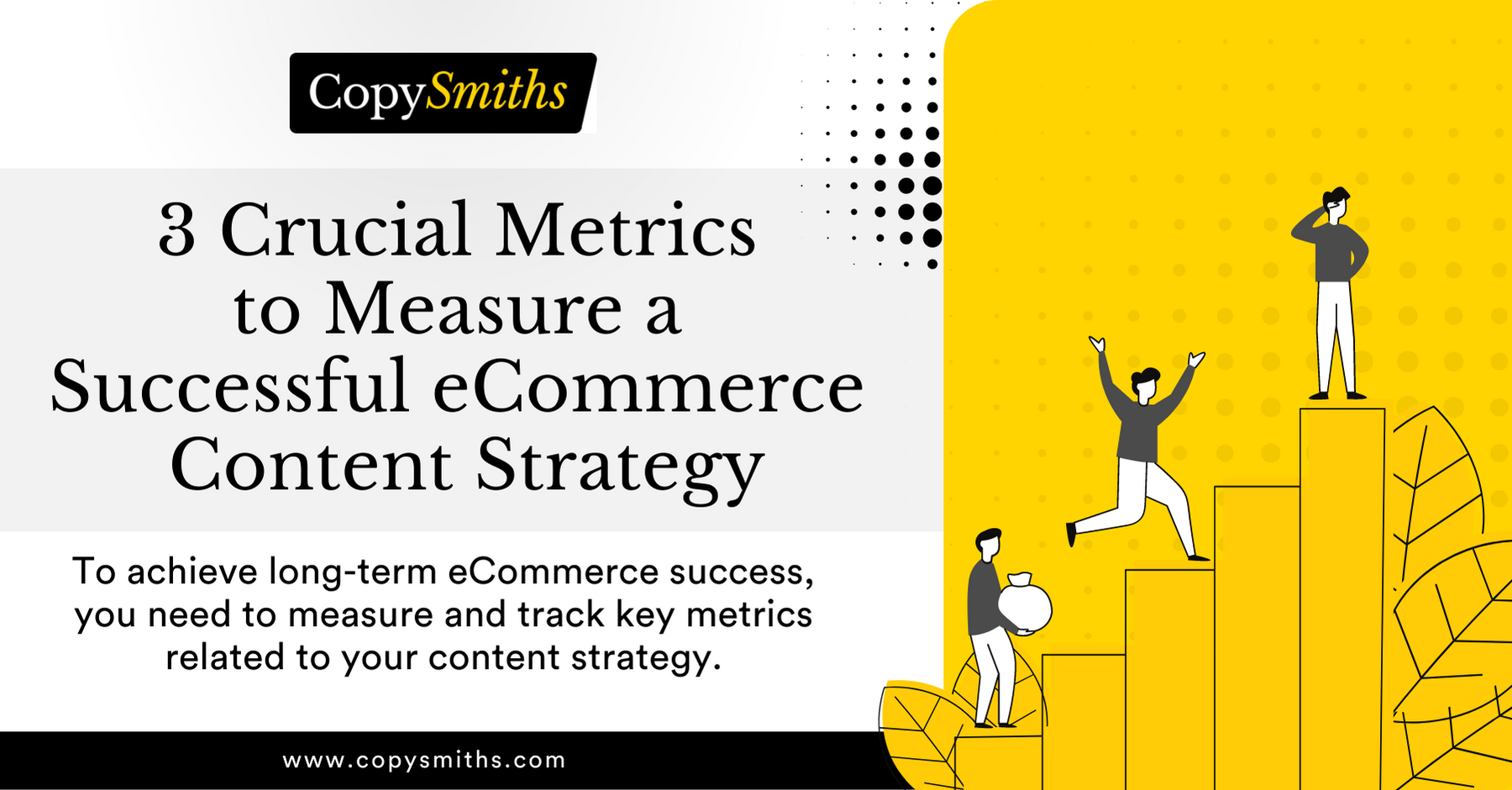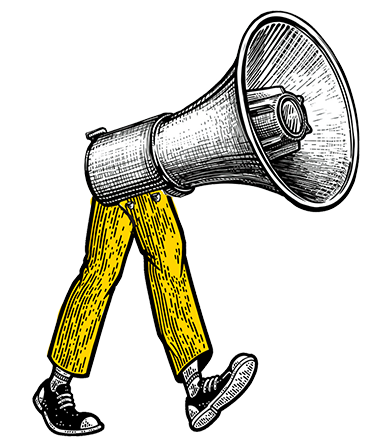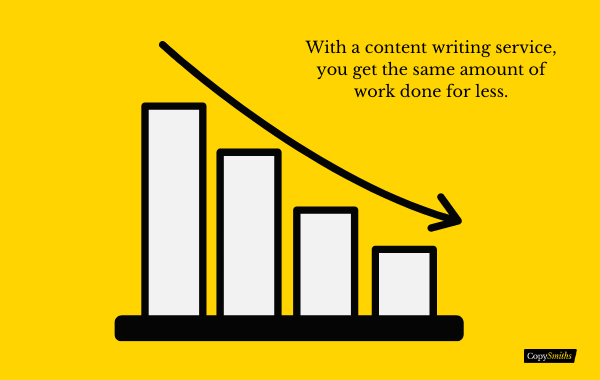Home » Content Marketing » 3 Crucial Metrics to Measure a Successful eCommerce Content Strategy

3 Crucial Metrics to Measure a Successful eCommerce Content Strategy
There’s more to eCommerce than meets the eye.
Many business owners assume that eCommerce is all about acquiring new customers and driving traffic to their websites. While those are undoubtedly important aspects of running a successful online store, they’re not the only aspects you need to focus on.
To achieve long-term eCommerce success, you need to measure and track key metrics related to your content strategy. By monitoring these metrics, you’ll be able to identify strengths and weaknesses in your content strategy and make necessary changes to improve your results and your website’s performance.
If you’re not sure which metrics to track, here are three of the most important ones.

1: Quality Web Traffic
A successful eCommerce content strategy drives quality web traffic to your website. Quality web traffic features prospective customers who take the desired action on your website, whether it’s subscribing to a newsletter, making a purchase, or filling out a form.
Quality web traffic is often targeted to audiences interested in your products and services.
On the other hand, non-quality web traffic consists of people not interested in what you’re selling. They may have clicked on an ad by mistake or typed in the wrong URL.
Generating quality web traffic is an ongoing process that starts with creating relevant and valuable content. This is content that does the following for your target audience:
- Solves a problem they’re facing
- Provides them with the information they need
- Entertains or educates them
Content Promotion
After creating quality content, you need to promote it to reach your target audience.
It’s worth noting that not all content marketing channels will work well for you. A successful eCommerce content strategy stipulates the best marketing channels to drive quality traffic.
The common approaches used in content promotion are:
- Email marketing: It involves sending your content to subscribers via email.
- Social media: Sharing your content on social media platforms like Twitter, Facebook, and LinkedIn.
- Paid advertising: Using paid advertising platforms like Google AdWords and Facebook Ads to promote your content.
- Guest posting: It involves publishing your content on other high-traffic websites . You’ll have to reach out to the website’s owner and request to publish on their website.
- Search Engine Optimization (SEO): It involves optimizing your content for search engines to make it easier for people to find. SEO generates organic traffic for your website.
There’s no one-size-fits-all solution when it comes to promoting content. The best way to find out what works is to experiment with the different channels and see what generates the most traffic for your website.
CopySmiths has been in the business of content creation for 25 years. Therefore, we’ve mastered the art of SEO. We’ve also worked with eCommerce stores in different industries, meaning we understand the different audiences you can target.
Here is what one of our clients had to say about our services:
“I am very happy with your company’s content output and professionalism. I will be recommending the use of your company’s services.”
— Chris.
2: Qualified Leads
Quality content often generates leadsA lead is a business or person that may eventually become a customer.
The quality of leads generated is a crucial metric to track in your eCommerce content strategy. After all, if you’re not generating high-quality leads, then you’re not accomplishing much.
There are different ways to measure the quality of your leads. For instance, if your content strategy stipulates using a lead magnet, you’ll tell if it’s attracting qualified leads by:
- Checking if people who read the content grab the lead magnet. This demonstrates that these people are interested in transacting with your business.
- Looking at the number of leads generated in relation to how many people visited your website. This helps you understand how well your content converts visitors into qualified leads.
- Analyzing the actions taken by website visitors. For example, did they check other resources that are part of your sales funnel, like a product page?
- Reviewing the visitors contacting you with pre-sales questions to inquire about your products and services.
A successful eCommerce content strategy ensures that audiences are converted into leads by creating attractive lead magnets and quality content that sends the traffic to product pages.
Another way to determine if your content attracts qualified leads is by using Google Analytics. Start by setting up your goals, navigate to conversions, goals, then funnel visualization. From here, you’ll see the contents that convert traffic into leads.
Expert Tip: If you want to generate high-quality leads, focus on building trust and authority so that when they’re ready to make a purchase, they’ll think of your eCommerce store first.
3: A High Conversion Rate
Conversion rate is the percentage of site visitors who take the desired action. The desired action could be anything from subscribing to a newsletter to making a purchase.
The formula for calculating conversion rate is CR= (Customers/Unique website visitors)*100.
Most eCommerce stores receive tons of traffic but no sales, resulting in a low conversion rate.
The table below shows the 2020 average eCommerce conversion rates for Great Britain, the United States of America, and EMEA countries:
| Countries | Q2 2020 | Q3 2020 | Q4 2020 |
| Great Britain | 4.0% | 4.4% | 4.5% |
| USA | 3.1% | 2.9% | 3.1% |
| EMEA | 2.0% | 1.8% | 2.2% |
A high conversion rate indicates your website is effective in achieving its goals. While, a low conversion rate says that something is preventing visitors from taking the desired action on your website.
The best way to increase your conversion rate is to persuade visitors to take the desired action. This is only possible if you provide them well-crafted and relevant content..
You can create different types of content to improve your conversion rate. The common ones include:
- Lead magnets like an e-book or a mini-course to prompt people to subscribe to your newsletter.
- Blog post copies and product descriptions to persuade people to purchase a product or service from your store.
- Landing pages with a compelling copy to influence people to sign up for free trials.
If you realize that your website has a low conversion rate, you’ll need to undertake a Conversion Rate Optimization (CRO). CRO involves making changes to your website to convert more visitors into customers.
Some of the changes include:
- Checking the content that converts leads to customers and optimizing other pieces of content on the website to be similar.
- Checking your sales funnel regularly to ensure that it’s working as intended.
- Monitoring visitors’ behavior on the site to determine if they visit essential pages like your product pages.
Outsource Your Content Generation Process
Source: CopySmiths
As you can see, a successful eCommerce content strategy must ensure quality web traffic, a high conversion rate, and qualified leads. These are the essential aspects needed for the success of your eCommerce store.
How do you ensure that your content strategy meets all these factors? It’s either by learning content generation, which takes a lot of time and costs quite a bit, or saving your time and effort by working with a content partner.
CopySmiths has mastered the art of eCommerce content generation and marketing. We create high-quality blog content for businesses at scale.
You’ll not have to worry about content ideation, generation, and publishing on your website with us. Contact us to get started today.
Frequently Asked Questions
How do you measure the success of a content strategy?
You can measure the success of a content strategy by:
- Looking at the quality of the traffic you get using Google Analytics
- Calculating your conversion rate
- Checking the quality of leads generated
If these metrics are high for your website, your content strategy is successful.
What’s the difference between quality web traffic and non-quality website traffic?
The critical difference between quality web traffic and non-quality website traffic is that quality web traffic is targeted. That means it’s made up of people interested in your products or services.
On the other hand, non-quality web traffic consists of people who are not interested in what you’re selling. They may have clicked on an ad by mistake or typed in the wrong URL.
What are some common approaches to content promotion?
The common approaches to content promotion are social media marketing, guest posting, SEO, and paid advertising.
CopySmiths
I'm Katrina McKinnon, founder of CopySmiths and Small Revolution. In my 20 years of experience, I have helped online businesses create high-performing content specifically on an eCommerce store's blog. Find me on LinkedIn and Twitter.

CopySmiths offers the best blog writing services for online stores.
If you'd like us to write blog articles for you, click here.
Most Recent
- 3 Bold Questions You Should Ask When Hiring A Content Writer

- 5 Practical Reasons You Should Use a Blog Post Template

- 4 Amazing Benefits of Using a Title Generator for New eCommerce Blogs

- 10 Awesome Bio Examples Your Online Store Blog Should Emulate

- 8 Basic Steps to Successful Content Development Every Time

Podcasts
Got a question?
Ask our friendly team about our article writing services.
Subscribe to CopyZine
Monthly, hand-picked stories of the best in eCommerce Content.





